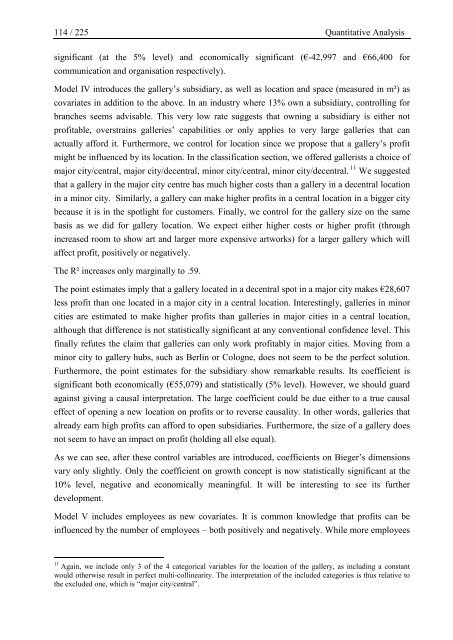Management of Art Galleries – Business Models - Universität St.Gallen
Management of Art Galleries – Business Models - Universität St.Gallen
Management of Art Galleries – Business Models - Universität St.Gallen
You also want an ePaper? Increase the reach of your titles
YUMPU automatically turns print PDFs into web optimized ePapers that Google loves.
114 / 225 Quantitative Analysissignificant (at the 5% level) and economically significant (€-42,997 and €66,400 forcommunication and organisation respectively).Model IV introduces the gallery’s subsidiary, as well as location and space (measured in m²) ascovariates in addition to the above. In an industry where 13% own a subsidiary, controlling forbranches seems advisable. This very low rate suggests that owning a subsidiary is either notpr<strong>of</strong>itable, overstrains galleries’ capabilities or only applies to very large galleries that canactually afford it. Furthermore, we control for location since we propose that a gallery’s pr<strong>of</strong>itmight be influenced by its location. In the classification section, we <strong>of</strong>fered gallerists a choice <strong>of</strong>major city/central, major city/decentral, minor city/central, minor city/decentral. 11 We suggestedthat a gallery in the major city centre has much higher costs than a gallery in a decentral locationin a minor city. Similarly, a gallery can make higher pr<strong>of</strong>its in a central location in a bigger citybecause it is in the spotlight for customers. Finally, we control for the gallery size on the samebasis as we did for gallery location. We expect either higher costs or higher pr<strong>of</strong>it (throughincreased room to show art and larger more expensive artworks) for a larger gallery which willaffect pr<strong>of</strong>it, positively or negatively.The R² increases only marginally to .59.The point estimates imply that a gallery located in a decentral spot in a major city makes €28,607less pr<strong>of</strong>it than one located in a major city in a central location. Interestingly, galleries in minorcities are estimated to make higher pr<strong>of</strong>its than galleries in major cities in a central location,although that difference is not statistically significant at any conventional confidence level. Thisfinally refutes the claim that galleries can only work pr<strong>of</strong>itably in major cities. Moving from aminor city to gallery hubs, such as Berlin or Cologne, does not seem to be the perfect solution.Furthermore, the point estimates for the subsidiary show remarkable results. Its coefficient issignificant both economically (€55,079) and statistically (5% level). However, we should guardagainst giving a causal interpretation. The large coefficient could be due either to a true causaleffect <strong>of</strong> opening a new location on pr<strong>of</strong>its or to reverse causality. In other words, galleries thatalready earn high pr<strong>of</strong>its can afford to open subsidiaries. Furthermore, the size <strong>of</strong> a gallery doesnot seem to have an impact on pr<strong>of</strong>it (holding all else equal).As we can see, after these control variables are introduced, coefficients on Bieger’s dimensionsvary only slightly. Only the coefficient on growth concept is now statistically significant at the10% level, negative and economically meaningful. It will be interesting to see its furtherdevelopment.Model V includes employees as new covariates. It is common knowledge that pr<strong>of</strong>its can beinfluenced by the number <strong>of</strong> employees – both positively and negatively. While more employees11 Again, we include only 3 <strong>of</strong> the 4 categorical variables for the location <strong>of</strong> the gallery, as including a constantwould otherwise result in perfect multi-collinearity. The interpretation <strong>of</strong> the included categories is thus relative tothe excluded one, which is “major city/central”.
















